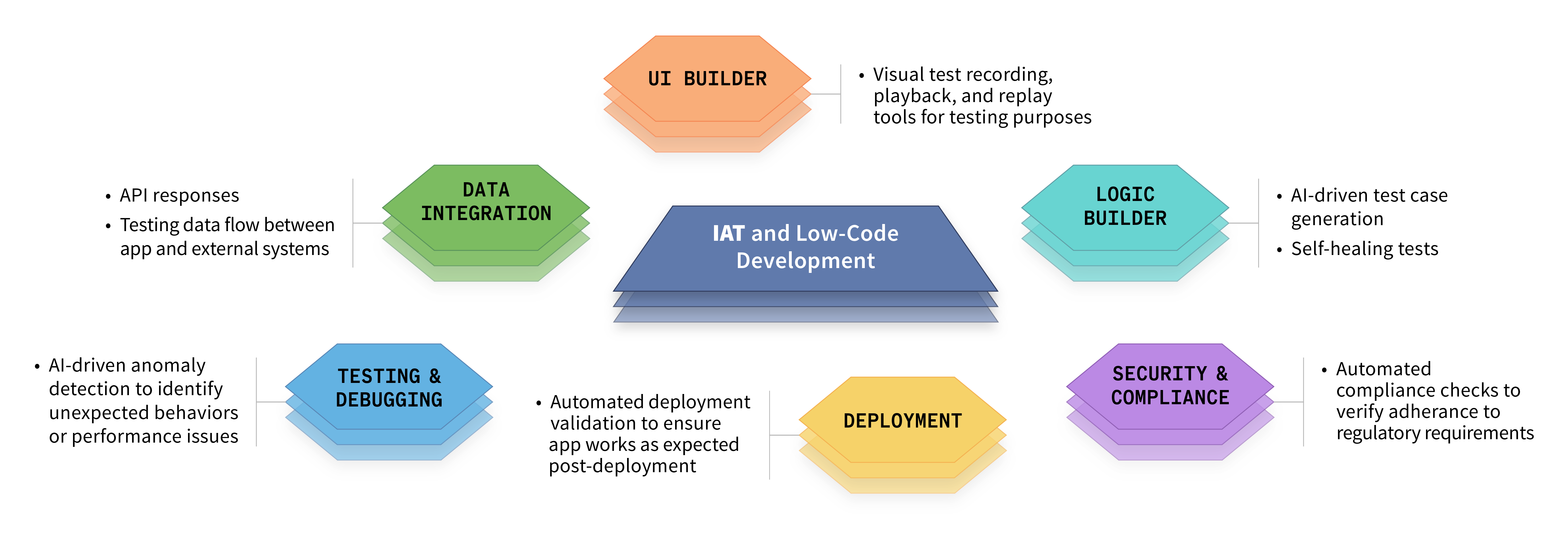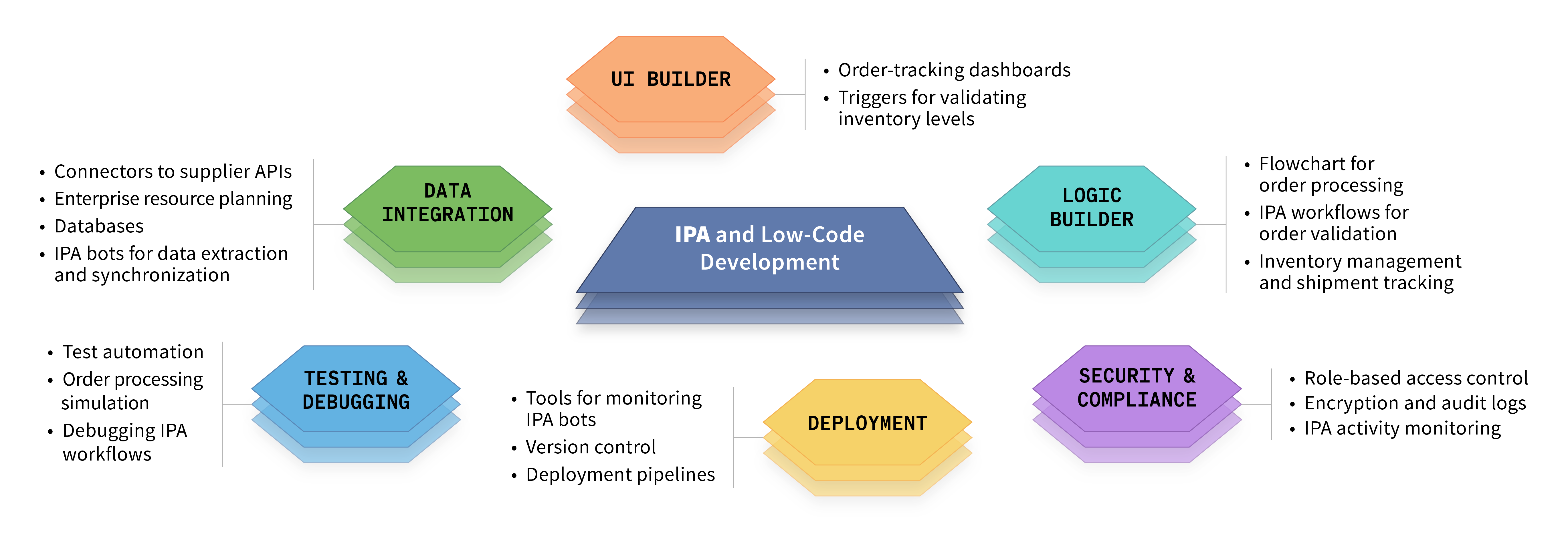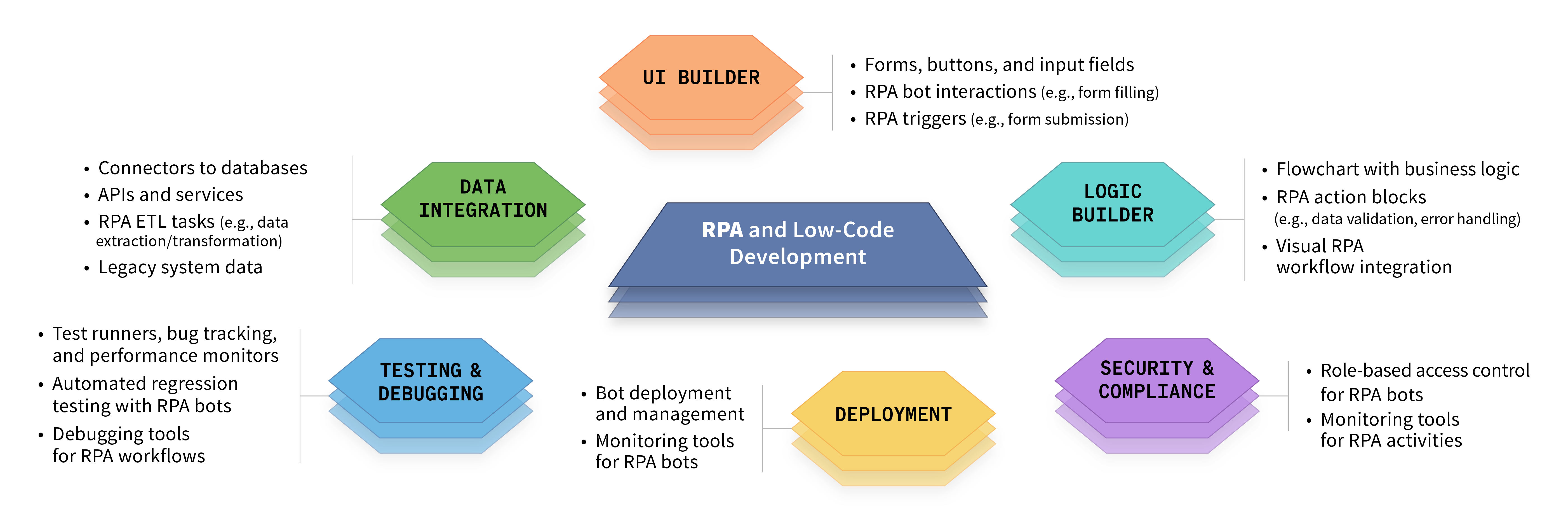Orchestrating IAT, IPA, and RPA With Low-Code Platforms: Benefits and Challenges of Advanced Automation and Testing
Through a technical deep dive on integrating process automation into low-code environments, understand why integration is vital to the future of organizations.
Join the DZone community and get the full member experience.
Join For FreeEditor's Note: The following is an article written for and published in DZone's 2024 Trend Report, Low-Code Development: Elevating the Engineering Experience With Low and No Code.
When software development teams face pressure to deliver high-quality applications rapidly, low-code platforms offer the needed support for rapidly evolving business requirements and complex integrations. Integrating intelligent automated testing (IAT), intelligent process automation (IPA), and robotic process automation (RPA) solutions, which can adapt to changes more readily, ensures that testing and automation keep pace with the evolving applications and processes. In a low-code development environment, as shown in Figure 1, IAT, IPA, and RPA can reduce manual effort and improve test coverage, accuracy, and efficiency in the SDLC and process automation.
Figure 1. Low-code development environment
 Using IAT, IPA, and RPA with low-code platforms can also achieve faster time to market, reduced costs, and increased productivity. The intersection of IAT, IPA, RPA, and low code is a paradigm shift in modern software development and process automation, and the impact extends to industries like professional services, consumer goods, banking, and beyond.
Using IAT, IPA, and RPA with low-code platforms can also achieve faster time to market, reduced costs, and increased productivity. The intersection of IAT, IPA, RPA, and low code is a paradigm shift in modern software development and process automation, and the impact extends to industries like professional services, consumer goods, banking, and beyond.
This article explores all three integrations. For each integration, we will highlight advantages and disadvantages, explore factors to consider when deciding whether to integrate, present a use case, and highlight key implementation points. The use cases presented are popular examples of how these technologies can be applied in specific scenarios. These use cases do not imply that each integration is limited to the mentioned domains, nor do they suggest that the integrations cannot be used differently within the same domains. The flexibility and versatility of the three integrations explored in this article allow for a wide range of applications across different industries and processes.
IAT With Low-Code Development
AI-driven test case generation in intelligent automated testing can explore more scenarios, edge cases, and application states, leading to better test coverage and higher application quality. This is particularly beneficial in low-code environments, where complex integrations and rapidly evolving requirements can make comprehensive testing challenging.
By automating testing tasks, such as test case generation, execution, and maintenance, IAT can significantly reduce the manual effort required, leading to increased efficiency and cost savings. This is advantageous in low-code development, where citizen developers with limited testing expertise are involved, minimizing the need for dedicated testing resources.
Low-code platforms enable rapid application development, but testing can become a bottleneck. Automated testing and IAT can provide rapid feedback on application quality and potential issues, enabling quicker identification and resolution of defects. This may accelerate the overall development and delivery cycle. It may also allow organizations to leverage the speed of low code while maintaining quality standards.
We need to keep in mind, though, that not all low-code platforms may integrate with all IAT solutions. IAT solutions may require access to sensitive application data, logs, and other information for training AI/ML models and generating test cases. In cases where training and software engineering skill development is necessary for AI/ML in IAT, we need to also consider costs like maintenance and support as well as customization and infrastructure.
The decision on whether to integrate IAT with a low-code platform involves a number of factors that are highlighted in the table below:
Table 1. Integrating IAT with low-code development
| When to Integrate | When Not to Integrate |
|---|---|
| Rapid development is critical, but only citizen developers with limited testing experience are available | Simple applications have limited functionality, and the low-code platform already provides sufficient testing capabilities |
| Applications built on low-code platforms have good options for IAT integration | Complexity and learning curve are high, and a deep understanding of AI/ML is required |
| Complex applications need comprehensive test coverage, requiring extensive testing | There are compatibility, interoperability, and data silo issues |
| Frequent release cycles have well-established CI/CD pipelines | Data security and regulatory compliance are challenges |
| Enhanced decision-making for testing process is needed | There are budget constraints |
Use Case: Professional Services
A low-code platform will be used to develop custom audit applications. Since IAT tools can be integrated to automate the testing of these applications, a professional services company will leverage IAT to enhance the accuracy, speed, efficiency, and effectiveness of its audit and assurance services. Implementation main points are summarized in Figure 2 below:
Figure 2. IAT with low-code development for a custom audit app

In this professional services use case for integrating IAT with low code, custom audit applications could also be developed for industries such as healthcare or finance, where automated testing can improve compliance and risk management.
IPA With Low-Code Development
Intelligent process automation may significantly enhance efficiency by automating various aspects of the software development and testing lifecycle. Low-code environments can benefit from IPA's advanced AI technologies, such as machine learning, natural language processing (NLP), and cognitive computing. These enhancements allow low-code platforms to automate more complex and data-intensive tasks that go beyond simple rule-based processes.
IPA is not limited to simple rule-based tasks; it incorporates cognitive automation capabilities. This makes IPA able to handle more complex scenarios involving unstructured data and decision-making. IPA can learn from data patterns and make decisions based on historical data and trends. This is particularly useful for testing scenarios that involve complex logic and variable outcomes. For example, IPA can handle unstructured data like text documents, images and emails by using NLP and optical character recognition.
IPA may be used to automate complex workflows and decision-making processes, reducing the need for manual intervention. End-to-end workflows and business processes can be automated, including approvals, notifications, and escalations. Automated decision-making can handle tasks such as credit scoring, risk assessment, and eligibility verification without human involvement based on predefined criteria and real-time data analysis. With IPA, low-code testing can go beyond testing applications since we can test entire processes across different verticals of an organization.
As IPA can support a wide range of integration scenarios across verticals, security and regulatory compliance may be an issue. If the low-code platform does not fully support the wide range of integrations available by IPA, then we need to consider alternatives. Infrastructure setup, data migration, data integration, licensing, and customization are examples of the costs involved.
The following table summarizes the factors to consider before integrating IPA:
Table 2. Integrating IPA with low-code development
| When to Integrate | When Not to Integrate |
|---|---|
| Stringent compliance and regulatory requirements exist that change in an adaptable, detailed, and easy-to-automate fashion | Regulatory and security compliance frameworks are too rigid, having security/compliance gaps with potential legal issues, leading to challenges and uncertainties |
| Repetitive processes exist across verticals where efficiency and accuracy can be enhanced | No clear optimization goals; manual processes are sufficient |
| Rapid development and deployment of scalable automation solutions is necessary | The low-code platform has limited customization for IPA |
| End-to-end business processes can be streamlined | There is limited IT expertise |
| Decision-making for complex process optimization is necessary | There are high initial implementation costs |
Use Case: Consumer Goods
A leading consumer goods company wants to utilize IPA to enhance its supply chain management and business operations. They will use a low-code platform to develop supply chain applications, and the platform will have the option to integrate IPA tools to automate and optimize supply chain processes. Such an integration will allow the company to improve supply chain efficiency, reduce operational costs, and enhance product delivery times. Implementation main points are summarized in Figure 3 below:
Figure 3. IPA with low-code development for a consumer goods company

This example of integrating IPA with low code in the consumer goods sector could be adapted for industries like retail or manufacturing, where inventory management, demand forecasting, and production scheduling can be optimized.
RPA With Low-Code Development
Robotic process automation and low-code development have a complementary relationship as they can be combined to enhance the overall automation and application development capabilities within an organization. For example, RPA can be used to automate repetitive tasks and integrate with various systems. Low-code platforms can be leveraged to build custom applications and workflows quickly, which may result in faster time to market. The rapid development capabilities of low-code platforms, combined with the automation power of RPA, may enable organizations to quickly build and deploy applications.
By automating repetitive tasks with RPA and rapidly building custom applications with low-code platforms, organizations can significantly improve their overall operational efficiency and productivity. RPA in a low-code environment can lead to cost savings by minimizing manual effort, reducing development time, and enabling citizen developers to contribute to application development.
Both RPA and low-code platforms offer scalability and flexibility, allowing organizations to adapt to changing business requirements and scale their applications and automated processes as needed. RPA bots can dynamically scale to handle varying volumes of customer queries. During peak times, additional bots can be deployed to manage the increased workload, ensuring consistent service levels. RPA tools often come with cross-platform compatibility, allowing them to interact with various applications and systems and enhancing the flexibility of low-code platforms.
Data sensitivity may be an issue here as RPA bots may directly access proprietary or sensitive data. For processes that are unstable, difficult to automate, or unpredictable, RPA may not provide the expected gains. RPA relies on structured data and predefined rules to execute tasks. Frequently changing, unstable, and unstructured processes that lack clear and consistent repetitive patterns may pose significant challenges for RPA bots. Processes that are complex to automate often involve multiple decision points, exceptions, and dependencies. While RPA can handle some level of complexity, it is not designed for tasks requiring deep context understanding or sophisticated decision-making capabilities.
The following table summarizes the factors to consider before integrating RPA:
Table 3. Integrating RPA with low-code development
| When to IntegratE | When NOT to Integrate |
|---|---|
| Existing system integrations can be further enhanced via automation | Tasks to be automated involve unstructured data and complex decision-making |
| Repetitive tasks and processes exist where manual processing is inefficient | Rapidly changing and complex processes must be automated |
| Cost savings are expected by automating heavy loads of structured and repetitive tasks | Implementation and maintenance costs of the integration are high |
| Scalability and flexibility of RPA can be leveraged by the low-code platform | There is a lack of technical expertise |
| Time to market is important | RPA bots operate on sensitive data without safeguarding |
Use Case: Banking
A banking organization aims to streamline its data entry processes by integrating RPA with low-code development platforms to automate repetitive and time-consuming tasks, such as form filling, data extraction, and data transfer between legacy and new systems. The integration is expected to enhance operational efficiency, reduce manual errors, ensure data accuracy, and increase customer satisfaction. Additionally, it will allow the bank to handle increased volumes of customer data with greater speed and reliability.
The low-code platform will provide the flexibility to rapidly develop and deploy custom applications tailored to the bank's specific needs. RPA will handle the automation of back-end processes, ensuring seamless and secure data management. Implementation main points are summarized in Figure 4 below:
Figure 4. RPA with low-code development for a banking organization

In this banking example for integrating RPA with low code, while RPA is used to automate back-end processes such as data entry and transfer, it can also automate front-end processes like customer service interactions and loan processing. Additionally, low code with RPA can be applied in domains such as insurance or telecommunications to automate claims processing and customer onboarding, respectively.
Conclusion
The value of technological integration lies in its ability to empower society and organizations to evolve, stay competitive, and thrive in a changing landscape — a landscape that calls for innovation and productivity to address market needs and societal changes. By embracing IAT, IPA, RPA, and low-code development, businesses can unlock new levels of agility, efficiency, and innovation. This will enable them to deliver exceptional customer experiences while driving sustainable growth and success.
As the digital transformation journey continues to unfold, the integration of IAT, IPA, and RPA with low-code development will play a pivotal role and shape the future of software development, process automation, and business operations across industries.
This is an excerpt from DZone's 2024 Trend Report, Low-Code Development: Elevating the Engineering Experience With Low and No Code.
Read the Free Report
Opinions expressed by DZone contributors are their own.

Comments